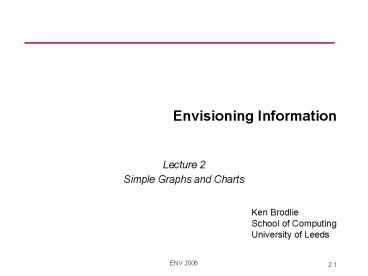Envisioning Information - PowerPoint PPT Presentation
1 / 21
Title:
Envisioning Information
Description:
Basic Datatypes correspond to different levels of measurement ... Car ownership by household income. Example taken from. NIST Handbook. Evidence of strong ... – PowerPoint PPT presentation
Number of Views:76
Avg rating:3.0/5.0
Title: Envisioning Information
1
Envisioning Information
- Lecture 2
- Simple Graphs and Charts
Ken Brodlie School of Computing University of
Leeds
2
Lecture Outline
- Preliminaries
- Definitions
- Datatypes
- Simple Data Presentation
- Graphs and charts
3
Fundamentals
- Basic Datatypes correspond to different levels of
measurement - Data can be
- Categorical - labels
- Numerical numbers
- Categorical
- Nominal
- No sense of order
- Apples, oranges,
- Ordinal
- Ordered in sequence
- January, February, ..
- Numerical
- Continuous
- Real numbers
- Height of students in class
- Discrete
- Typically whole numbers
- Marks in an exam
4
Question
- Give an example for each class in which numbers
are involved
- Categorical - nominal
- Categorical - ordinal
- Numerical continuous
- Numerical - discrete
5
Exploratory Data Analysis
- Two stage process
- Exploratory Search for evidence using all tools
available - Confirmatory evaluate strength of evidence using
classical data analysis
- Pioneering figure is John Tukey
- New approach to data analysis, heavily based on
visualization, as an alternative to classical
data analysis - See wikipedia
6
Simple Data Presentation
7
Simple Data Presentation
- Simple data tables are often presented as line
graphs, bar graphs, pie charts, dot graphs,
histograms - Which should we use and when?
8
Line Graph
- Fundamental technique of data presentation
- Used to compare two variables
- X-axis is often the control variable
- Y-axis is the response variable
- Good at
- Showing specific values
- Trends
- Trends in groups (using multiple line graphs)
Students participating in sporting activities
Any critical comments here?
Note graph labelling is fundamental
9
Simple Representations Bar Graph
- Bar graph
- Presents categorical variables
- Height of bar indicates value
- Double bar graph allows comparison
- Note spacing between bars
- Can be horizontal (when would you use this?)
Number of police officers
Internet use at a school
Note more space for labels
10
Dot Graph
- Very simple but effective
- Horizontal to give more space for labelling
11
Pie Chart
- Pie chart summarises a set of categorical/nominal
data - But use with care
- too many segments are harder to compare than in
a bar chart
Should we have a long lecture?
Favourite movie genres
12
Histograms
- Histograms summarise discrete or continuous data
that are measured on an interval scale - No gaps if variable is continuous
Distribution of salaries in a company
13
Scatter Plot
- Used to present measurements of two variables
- Effective if a relationship exists between the
two variables
Car ownership by household income
14
Scatter Plots in Excel
- The scatter plot is a fundamental tool in Excel
- Chart type XY (Scatter) and subtype Unconnected
Points
http//www2.ncsu.edu8010/ncsu/chemistry/resource/
excel/excel.html
15
Regression Line
- Excel allows you to add a linear regression line
(trend line)
Remember correlation does not imply causality
ie a relationship exists but one is not
necessarily causing the other there may be
a third factor?
16
Tukey Sum-Difference Plot
Better understanding of residuals
17
Box Plots
- In some situations we have, not a single data
value at a point, but a number of data values, or
even a probability distribution - When might this occur?
- Tukey proposed the idea of a boxplot to visualize
the distribution of values - For explanation and some history, see
- http//mathworld.wolfram.com/Box-and-WhiskerPlot.h
tml - http//en.wikipedia.org/wiki/Box_plot
M median Q1, Q3 quarrtiles Whiskers 1.5
interquartile range Dots - outliers
18
Acknowledgement
- Thanks to Statistics Canada an excellent web
site for simple data presentation - http//www.statcan.ca/english/edu/power/toc/conten
ts.htm
19
Exercise for next week
- Understand a bit more about the merits of pie
charts and bar graphs - Create a dataset with roughly equal numbers in
each class - Which is best if the task is to discriminate?
20
Exercise for next week
- Over the next week look for examples of basic
graphs - In newspapers, magazines or other print media
- On news web sites or other electronic media
- Analyse two examples
- One should be a example where you think the use
of graphics is good - One should be bad
- Be ready next week to present these results to
the class
21
Envisioning Information Practical Work
- Gnuplot
- R
- Excel































